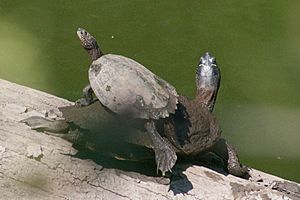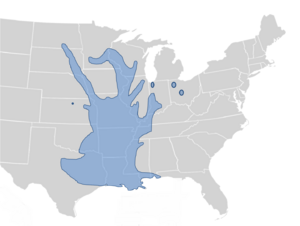False map turtle facts for kids
Quick facts for kids False map turtle |
|
|---|---|
 |
|
| Conservation status | |
| Scientific classification | |
| Genus: |
Graptemys
|
| Species: |
pseudogeographica
|
| Subspecies | |
|
|
 |
|
| Range map | |
The false map turtle (Graptemys pseudogeographica) is a type of turtle that lives only in the United States. It is a common pet. There are two main kinds, or subspecies, of this turtle.
Contents
What Does a False Map Turtle Look Like?
False map turtles are sometimes called "sawback" turtles. This is because their top shell, called a carapace, has a row of small bumps like a saw. The back edge of their shell is also bumpy.
Their shell is usually olive green to brown. It has light yellow marks with dark edges. The bottom shell, called a plastron, is cream or yellow. Young turtles have dark lines on their plastron.
The turtle's body is grayish-brown to black. It has light brown, yellow, or white stripes. Their eyes can be brown, yellow, white, or green. A dark line crosses their eye. They also have thin, hooked marks behind their eyes. These marks connect to lines on their head and neck. Small light spots are found below their eyes and on their chin.
Where Do False Map Turtles Live?
False map turtles live in big rivers and streams. They are found in the Missouri and Mississippi River systems. Their home range goes from Ohio and Indiana in the east. It stretches through Illinois, Wisconsin, and Minnesota. It also reaches the Dakotas. In the south, they live in Alabama, Mississippi, and Louisiana. You can also find them in some rivers in Southwest Louisiana and East Texas.
How Do They Behave?
Map turtles, including the false map turtle, love to bask in the sun. They spend many hours each day warming up. When they are with other turtles, they often share basking spots. They also watch out for danger together. This teamwork helps them stay safe from predators.
Different Kinds of False Map Turtles
There are two recognized subspecies of the false map turtle:
- The regular false map turtle: G. p. pseudogeographica (named by Gray in 1831).
- The Mississippi map turtle: G. p. kohnii (named by Baur in 1890).
What is Their Home Like?
False map turtles are very good swimmers. They prefer rivers and large creeks. These places usually have a steady current. They like areas with water plants and floating logs or tree branches. These logs are great for basking. They are also comfortable in deep, fast-moving water.
You might find these turtles in oxbow lakes and sloughs. These are calm water areas next to rivers. However, they usually do not live in lakes, ponds, or small streams. Basking is very important for these turtles. They can even climb onto slippery logs to sunbathe.
What Dangers Do They Face?
False map turtles face several challenges. Sometimes, animals and insects destroy their egg nests. They can also get caught in fishing nets. Like some other turtles, false map turtles have been collected to be sold as pets.
Gallery




